Whitley Corporation: Deferred Tax and Financial Statement Analysis
VerifiedAdded on 2023/06/10
|7
|1307
|205
Case Study
AI Summary
This case study delves into the financial decisions facing Whitley Corporation, focusing on whether to purchase new equipment in the current year or defer the purchase to the next year. The analysis considers the impact of these decisions on the company's tax payable, earnings per share (EPS), and overall financial statement appearance. The study computes the income tax payable under both scenarios, highlighting the ethical considerations related to manipulating financial statements to present a misleadingly positive view to potential investors. It also examines the effects on current assets, non-current assets, liabilities, and key financial ratios like debt to equity and EPS. The case concludes by emphasizing the importance of presenting a true and fair view of the company's financial position, irrespective of the economic realities, in accordance with accounting standards. Desklib provides similar solved assignments for students.
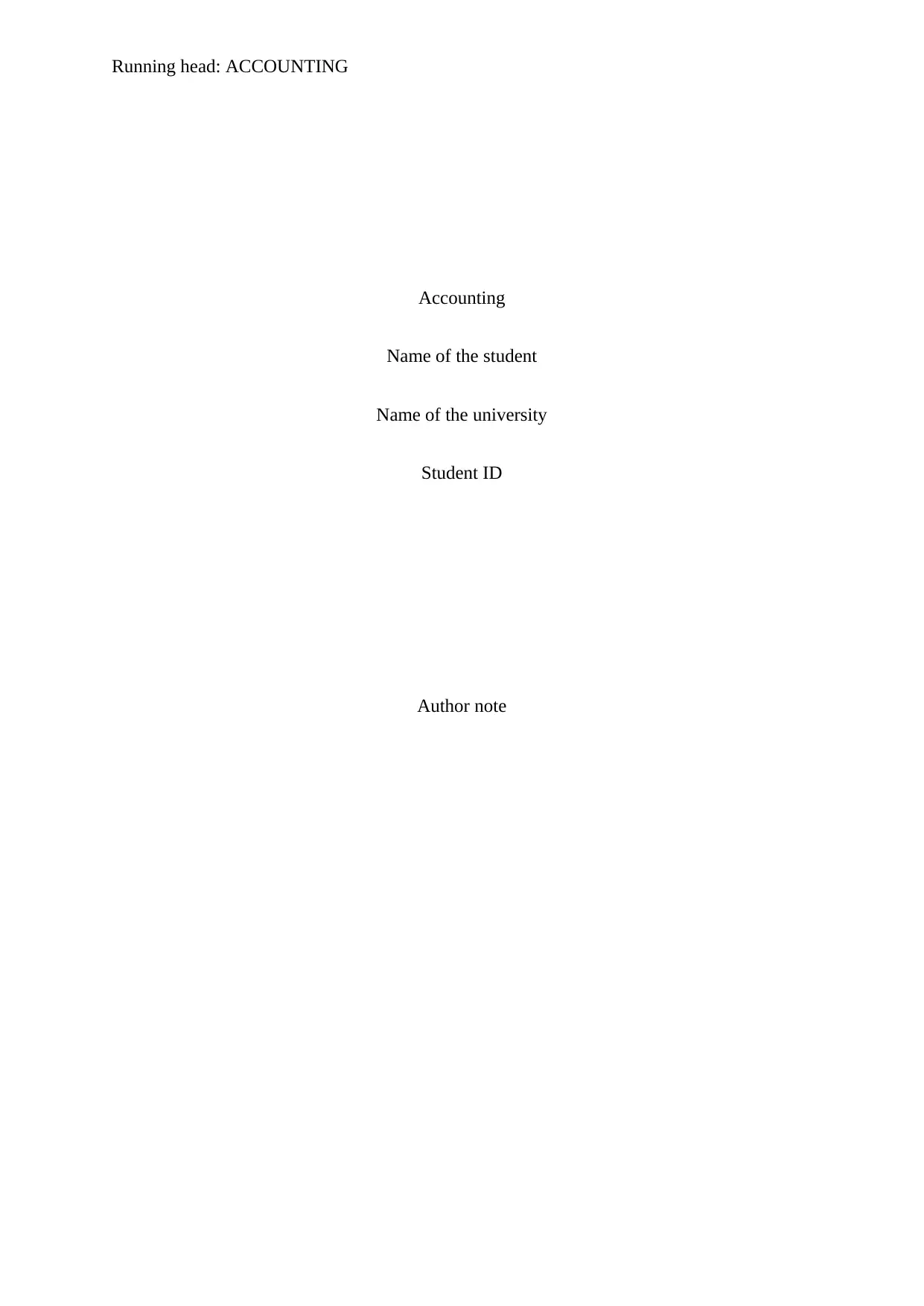
Running head: ACCOUNTING
Accounting
Name of the student
Name of the university
Student ID
Author note
Accounting
Name of the student
Name of the university
Student ID
Author note
Paraphrase This Document
Need a fresh take? Get an instant paraphrase of this document with our AI Paraphraser
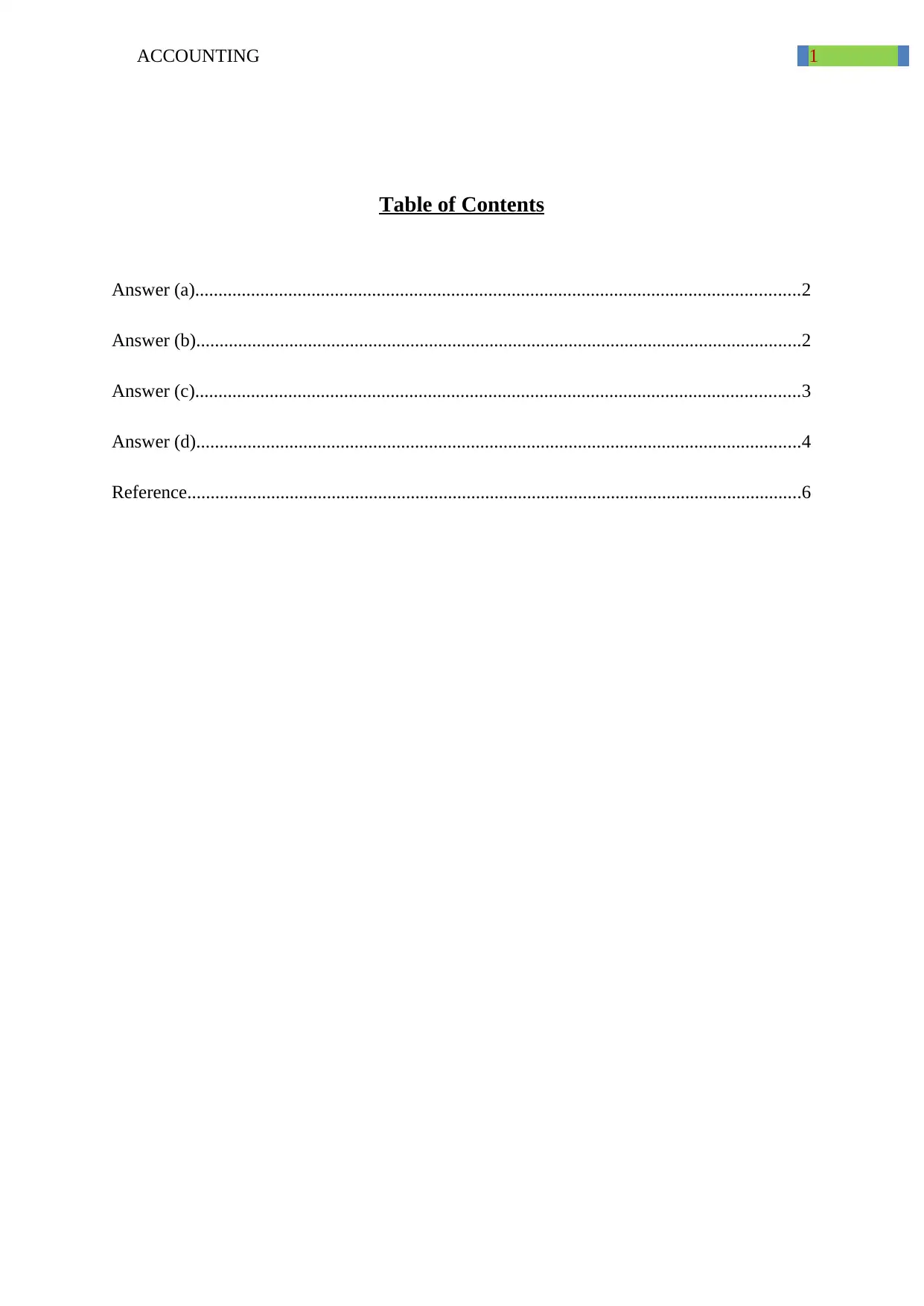
1ACCOUNTING
Table of Contents
Answer (a)..................................................................................................................................2
Answer (b)..................................................................................................................................2
Answer (c)..................................................................................................................................3
Answer (d)..................................................................................................................................4
Reference....................................................................................................................................6
Table of Contents
Answer (a)..................................................................................................................................2
Answer (b)..................................................................................................................................2
Answer (c)..................................................................................................................................3
Answer (d)..................................................................................................................................4
Reference....................................................................................................................................6
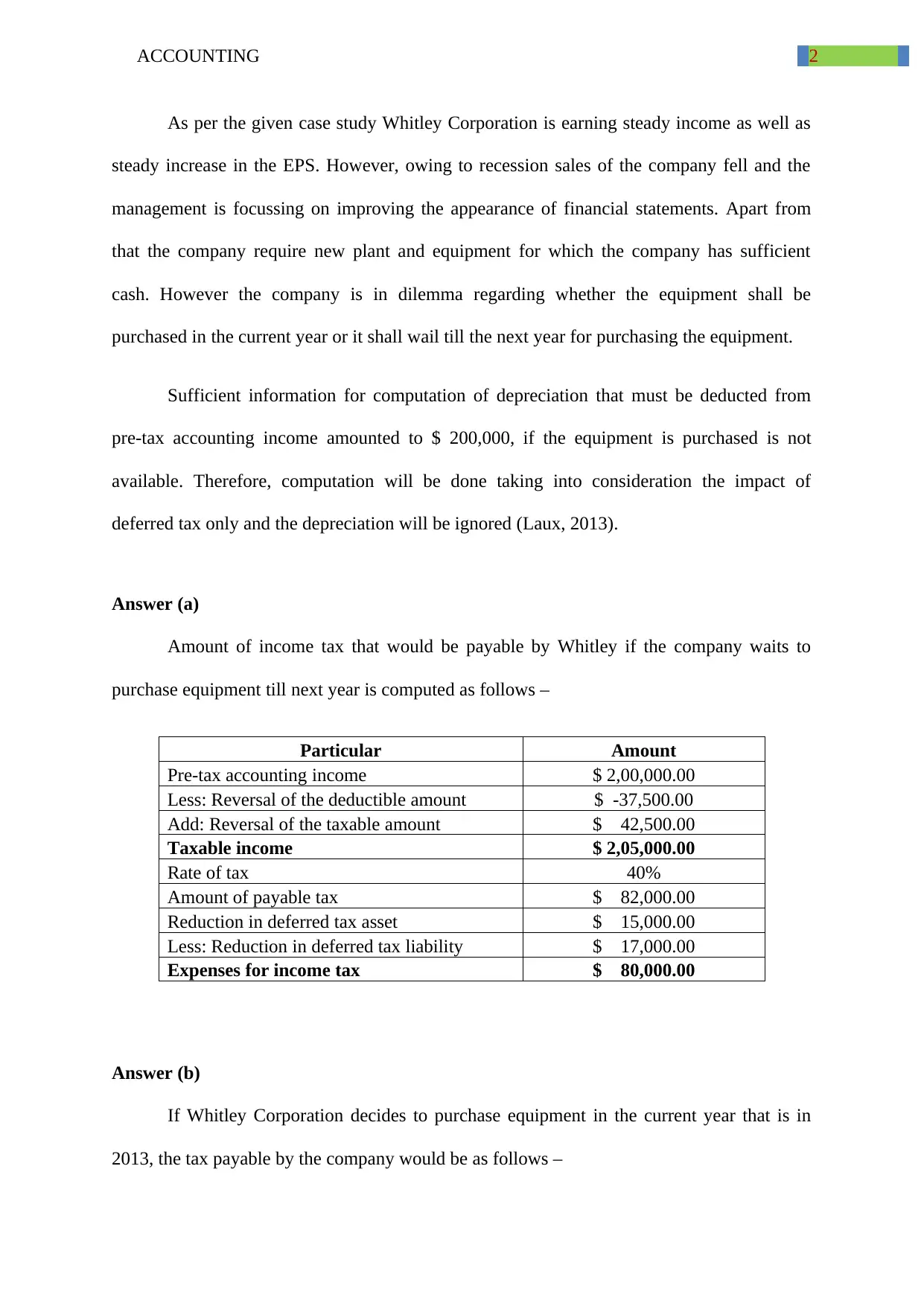
2ACCOUNTING
As per the given case study Whitley Corporation is earning steady income as well as
steady increase in the EPS. However, owing to recession sales of the company fell and the
management is focussing on improving the appearance of financial statements. Apart from
that the company require new plant and equipment for which the company has sufficient
cash. However the company is in dilemma regarding whether the equipment shall be
purchased in the current year or it shall wail till the next year for purchasing the equipment.
Sufficient information for computation of depreciation that must be deducted from
pre-tax accounting income amounted to $ 200,000, if the equipment is purchased is not
available. Therefore, computation will be done taking into consideration the impact of
deferred tax only and the depreciation will be ignored (Laux, 2013).
Answer (a)
Amount of income tax that would be payable by Whitley if the company waits to
purchase equipment till next year is computed as follows –
Particular Amount
Pre-tax accounting income $ 2,00,000.00
Less: Reversal of the deductible amount $ -37,500.00
Add: Reversal of the taxable amount $ 42,500.00
Taxable income $ 2,05,000.00
Rate of tax 40%
Amount of payable tax $ 82,000.00
Reduction in deferred tax asset $ 15,000.00
Less: Reduction in deferred tax liability $ 17,000.00
Expenses for income tax $ 80,000.00
Answer (b)
If Whitley Corporation decides to purchase equipment in the current year that is in
2013, the tax payable by the company would be as follows –
As per the given case study Whitley Corporation is earning steady income as well as
steady increase in the EPS. However, owing to recession sales of the company fell and the
management is focussing on improving the appearance of financial statements. Apart from
that the company require new plant and equipment for which the company has sufficient
cash. However the company is in dilemma regarding whether the equipment shall be
purchased in the current year or it shall wail till the next year for purchasing the equipment.
Sufficient information for computation of depreciation that must be deducted from
pre-tax accounting income amounted to $ 200,000, if the equipment is purchased is not
available. Therefore, computation will be done taking into consideration the impact of
deferred tax only and the depreciation will be ignored (Laux, 2013).
Answer (a)
Amount of income tax that would be payable by Whitley if the company waits to
purchase equipment till next year is computed as follows –
Particular Amount
Pre-tax accounting income $ 2,00,000.00
Less: Reversal of the deductible amount $ -37,500.00
Add: Reversal of the taxable amount $ 42,500.00
Taxable income $ 2,05,000.00
Rate of tax 40%
Amount of payable tax $ 82,000.00
Reduction in deferred tax asset $ 15,000.00
Less: Reduction in deferred tax liability $ 17,000.00
Expenses for income tax $ 80,000.00
Answer (b)
If Whitley Corporation decides to purchase equipment in the current year that is in
2013, the tax payable by the company would be as follows –
⊘ This is a preview!⊘
Do you want full access?
Subscribe today to unlock all pages.

Trusted by 1+ million students worldwide
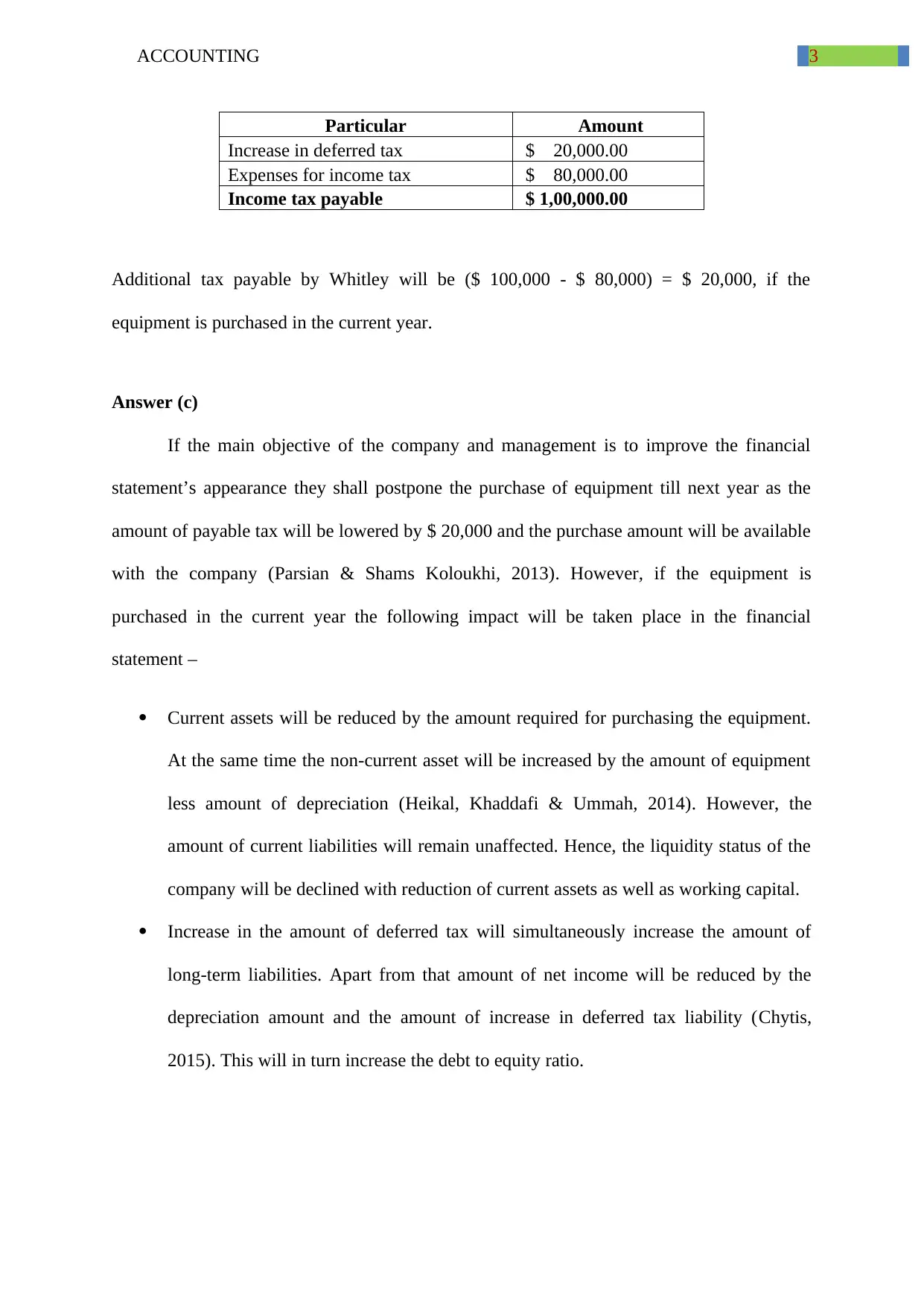
3ACCOUNTING
Particular Amount
Increase in deferred tax $ 20,000.00
Expenses for income tax $ 80,000.00
Income tax payable $ 1,00,000.00
Additional tax payable by Whitley will be ($ 100,000 - $ 80,000) = $ 20,000, if the
equipment is purchased in the current year.
Answer (c)
If the main objective of the company and management is to improve the financial
statement’s appearance they shall postpone the purchase of equipment till next year as the
amount of payable tax will be lowered by $ 20,000 and the purchase amount will be available
with the company (Parsian & Shams Koloukhi, 2013). However, if the equipment is
purchased in the current year the following impact will be taken place in the financial
statement –
Current assets will be reduced by the amount required for purchasing the equipment.
At the same time the non-current asset will be increased by the amount of equipment
less amount of depreciation (Heikal, Khaddafi & Ummah, 2014). However, the
amount of current liabilities will remain unaffected. Hence, the liquidity status of the
company will be declined with reduction of current assets as well as working capital.
Increase in the amount of deferred tax will simultaneously increase the amount of
long-term liabilities. Apart from that amount of net income will be reduced by the
depreciation amount and the amount of increase in deferred tax liability (Chytis,
2015). This will in turn increase the debt to equity ratio.
Particular Amount
Increase in deferred tax $ 20,000.00
Expenses for income tax $ 80,000.00
Income tax payable $ 1,00,000.00
Additional tax payable by Whitley will be ($ 100,000 - $ 80,000) = $ 20,000, if the
equipment is purchased in the current year.
Answer (c)
If the main objective of the company and management is to improve the financial
statement’s appearance they shall postpone the purchase of equipment till next year as the
amount of payable tax will be lowered by $ 20,000 and the purchase amount will be available
with the company (Parsian & Shams Koloukhi, 2013). However, if the equipment is
purchased in the current year the following impact will be taken place in the financial
statement –
Current assets will be reduced by the amount required for purchasing the equipment.
At the same time the non-current asset will be increased by the amount of equipment
less amount of depreciation (Heikal, Khaddafi & Ummah, 2014). However, the
amount of current liabilities will remain unaffected. Hence, the liquidity status of the
company will be declined with reduction of current assets as well as working capital.
Increase in the amount of deferred tax will simultaneously increase the amount of
long-term liabilities. Apart from that amount of net income will be reduced by the
depreciation amount and the amount of increase in deferred tax liability (Chytis,
2015). This will in turn increase the debt to equity ratio.
Paraphrase This Document
Need a fresh take? Get an instant paraphrase of this document with our AI Paraphraser
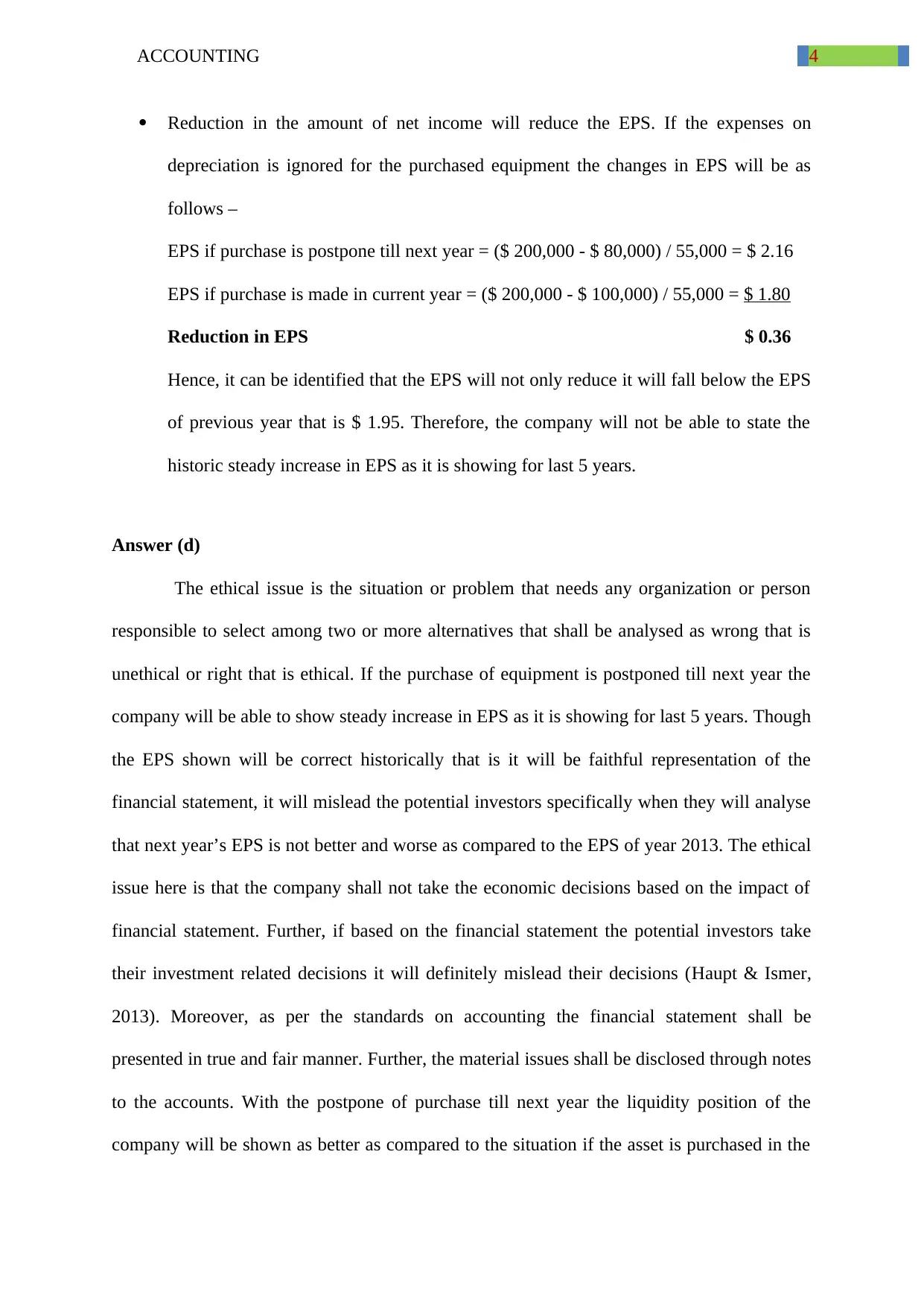
4ACCOUNTING
Reduction in the amount of net income will reduce the EPS. If the expenses on
depreciation is ignored for the purchased equipment the changes in EPS will be as
follows –
EPS if purchase is postpone till next year = ($ 200,000 - $ 80,000) / 55,000 = $ 2.16
EPS if purchase is made in current year = ($ 200,000 - $ 100,000) / 55,000 = $ 1.80
Reduction in EPS $ 0.36
Hence, it can be identified that the EPS will not only reduce it will fall below the EPS
of previous year that is $ 1.95. Therefore, the company will not be able to state the
historic steady increase in EPS as it is showing for last 5 years.
Answer (d)
The ethical issue is the situation or problem that needs any organization or person
responsible to select among two or more alternatives that shall be analysed as wrong that is
unethical or right that is ethical. If the purchase of equipment is postponed till next year the
company will be able to show steady increase in EPS as it is showing for last 5 years. Though
the EPS shown will be correct historically that is it will be faithful representation of the
financial statement, it will mislead the potential investors specifically when they will analyse
that next year’s EPS is not better and worse as compared to the EPS of year 2013. The ethical
issue here is that the company shall not take the economic decisions based on the impact of
financial statement. Further, if based on the financial statement the potential investors take
their investment related decisions it will definitely mislead their decisions (Haupt & Ismer,
2013). Moreover, as per the standards on accounting the financial statement shall be
presented in true and fair manner. Further, the material issues shall be disclosed through notes
to the accounts. With the postpone of purchase till next year the liquidity position of the
company will be shown as better as compared to the situation if the asset is purchased in the
Reduction in the amount of net income will reduce the EPS. If the expenses on
depreciation is ignored for the purchased equipment the changes in EPS will be as
follows –
EPS if purchase is postpone till next year = ($ 200,000 - $ 80,000) / 55,000 = $ 2.16
EPS if purchase is made in current year = ($ 200,000 - $ 100,000) / 55,000 = $ 1.80
Reduction in EPS $ 0.36
Hence, it can be identified that the EPS will not only reduce it will fall below the EPS
of previous year that is $ 1.95. Therefore, the company will not be able to state the
historic steady increase in EPS as it is showing for last 5 years.
Answer (d)
The ethical issue is the situation or problem that needs any organization or person
responsible to select among two or more alternatives that shall be analysed as wrong that is
unethical or right that is ethical. If the purchase of equipment is postponed till next year the
company will be able to show steady increase in EPS as it is showing for last 5 years. Though
the EPS shown will be correct historically that is it will be faithful representation of the
financial statement, it will mislead the potential investors specifically when they will analyse
that next year’s EPS is not better and worse as compared to the EPS of year 2013. The ethical
issue here is that the company shall not take the economic decisions based on the impact of
financial statement. Further, if based on the financial statement the potential investors take
their investment related decisions it will definitely mislead their decisions (Haupt & Ismer,
2013). Moreover, as per the standards on accounting the financial statement shall be
presented in true and fair manner. Further, the material issues shall be disclosed through notes
to the accounts. With the postpone of purchase till next year the liquidity position of the
company will be shown as better as compared to the situation if the asset is purchased in the
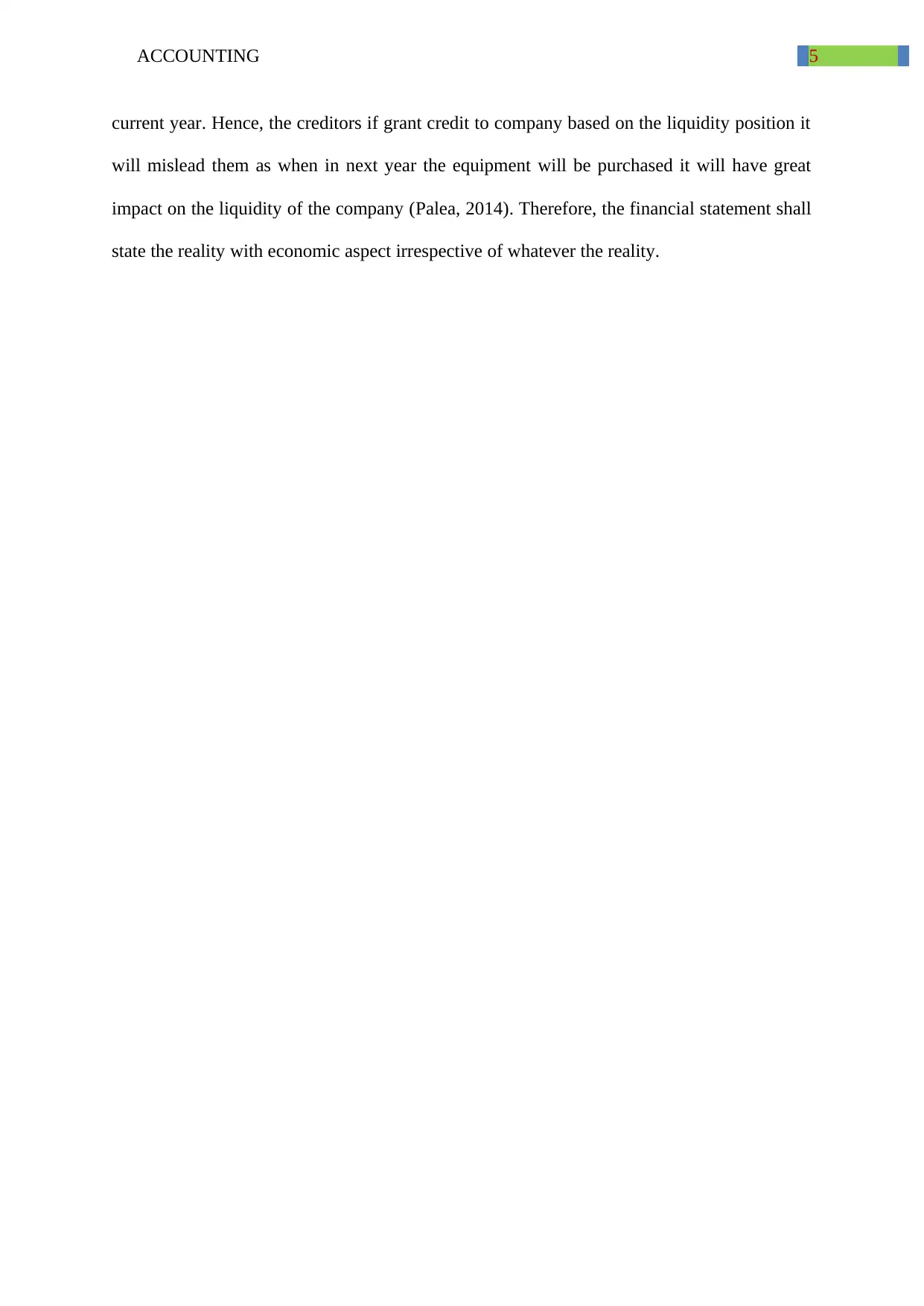
5ACCOUNTING
current year. Hence, the creditors if grant credit to company based on the liquidity position it
will mislead them as when in next year the equipment will be purchased it will have great
impact on the liquidity of the company (Palea, 2014). Therefore, the financial statement shall
state the reality with economic aspect irrespective of whatever the reality.
current year. Hence, the creditors if grant credit to company based on the liquidity position it
will mislead them as when in next year the equipment will be purchased it will have great
impact on the liquidity of the company (Palea, 2014). Therefore, the financial statement shall
state the reality with economic aspect irrespective of whatever the reality.
⊘ This is a preview!⊘
Do you want full access?
Subscribe today to unlock all pages.

Trusted by 1+ million students worldwide
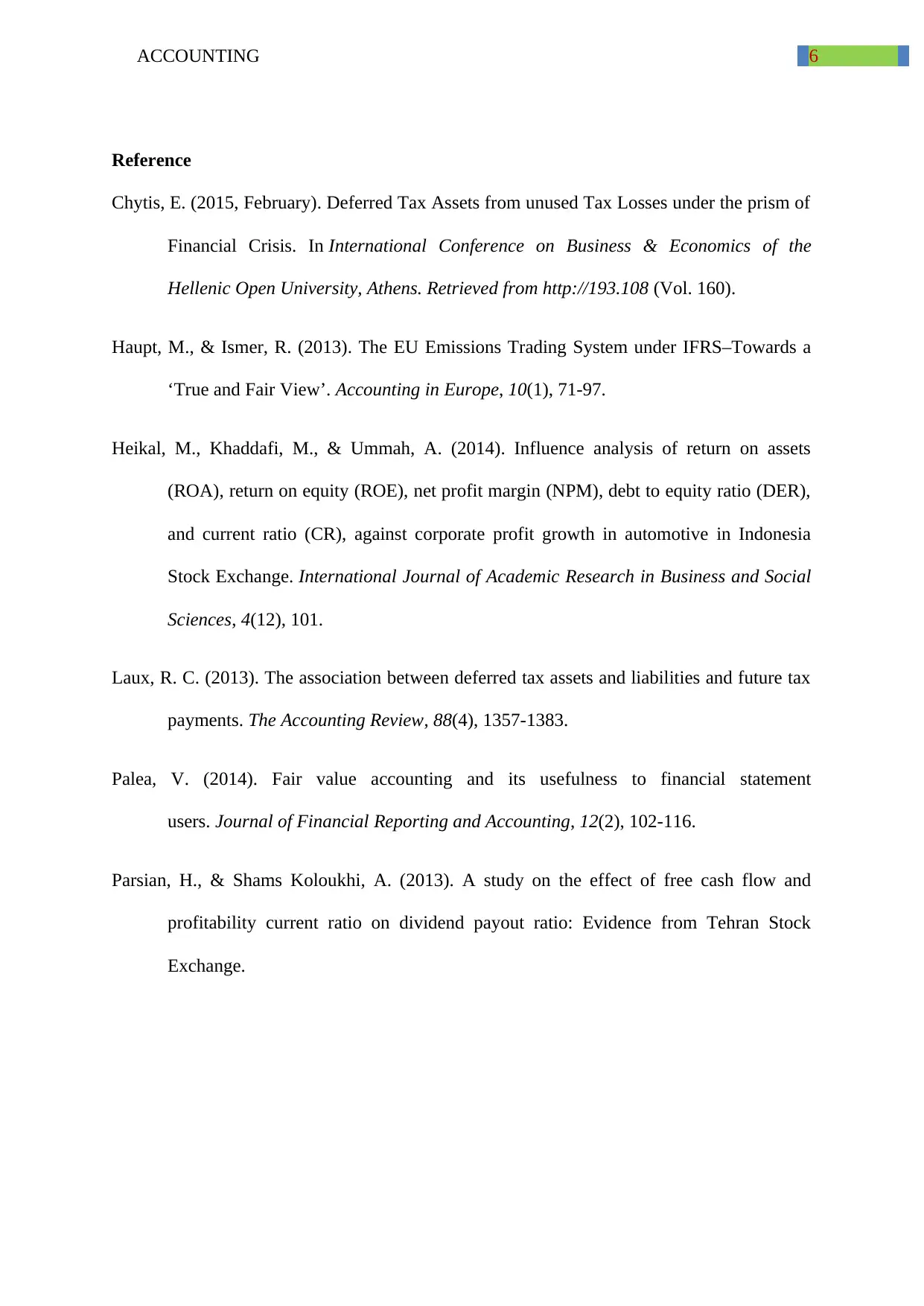
6ACCOUNTING
Reference
Chytis, E. (2015, February). Deferred Tax Assets from unused Tax Losses under the prism of
Financial Crisis. In International Conference on Business & Economics of the
Hellenic Open University, Athens. Retrieved from http://193.108 (Vol. 160).
Haupt, M., & Ismer, R. (2013). The EU Emissions Trading System under IFRS–Towards a
‘True and Fair View’. Accounting in Europe, 10(1), 71-97.
Heikal, M., Khaddafi, M., & Ummah, A. (2014). Influence analysis of return on assets
(ROA), return on equity (ROE), net profit margin (NPM), debt to equity ratio (DER),
and current ratio (CR), against corporate profit growth in automotive in Indonesia
Stock Exchange. International Journal of Academic Research in Business and Social
Sciences, 4(12), 101.
Laux, R. C. (2013). The association between deferred tax assets and liabilities and future tax
payments. The Accounting Review, 88(4), 1357-1383.
Palea, V. (2014). Fair value accounting and its usefulness to financial statement
users. Journal of Financial Reporting and Accounting, 12(2), 102-116.
Parsian, H., & Shams Koloukhi, A. (2013). A study on the effect of free cash flow and
profitability current ratio on dividend payout ratio: Evidence from Tehran Stock
Exchange.
Reference
Chytis, E. (2015, February). Deferred Tax Assets from unused Tax Losses under the prism of
Financial Crisis. In International Conference on Business & Economics of the
Hellenic Open University, Athens. Retrieved from http://193.108 (Vol. 160).
Haupt, M., & Ismer, R. (2013). The EU Emissions Trading System under IFRS–Towards a
‘True and Fair View’. Accounting in Europe, 10(1), 71-97.
Heikal, M., Khaddafi, M., & Ummah, A. (2014). Influence analysis of return on assets
(ROA), return on equity (ROE), net profit margin (NPM), debt to equity ratio (DER),
and current ratio (CR), against corporate profit growth in automotive in Indonesia
Stock Exchange. International Journal of Academic Research in Business and Social
Sciences, 4(12), 101.
Laux, R. C. (2013). The association between deferred tax assets and liabilities and future tax
payments. The Accounting Review, 88(4), 1357-1383.
Palea, V. (2014). Fair value accounting and its usefulness to financial statement
users. Journal of Financial Reporting and Accounting, 12(2), 102-116.
Parsian, H., & Shams Koloukhi, A. (2013). A study on the effect of free cash flow and
profitability current ratio on dividend payout ratio: Evidence from Tehran Stock
Exchange.
1 out of 7
Related Documents
Your All-in-One AI-Powered Toolkit for Academic Success.
+13062052269
info@desklib.com
Available 24*7 on WhatsApp / Email
![[object Object]](/_next/static/media/star-bottom.7253800d.svg)
Unlock your academic potential
Copyright © 2020–2025 A2Z Services. All Rights Reserved. Developed and managed by ZUCOL.





